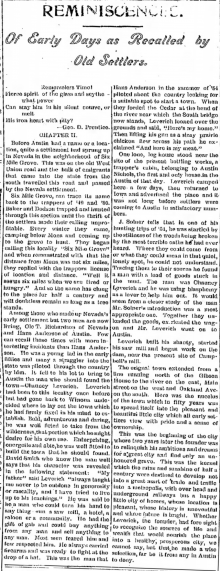Reminiscences of Old Days Recalled by Early Pioneers - Six Mile Grove naming
REMINISCENSES.
Of Early Days as Recalled by
Old Settlers.
Remorselers Time!
Fierce spirit of the glass and seythe
what power
Can stay him in his silent course, or
melt
His iron heart with pity?
-Geo. D. Prentice.
CHAPTER II.
Before Austin had a name or a location, quite a settlement had sprung up in Nevada in the neighborhood of Six Mile Grove. This was on the old West Union road and the bulk of emigrants that came into the state from the south travelled this road and passed by the Nevada settlement.
Six Mile Grove, can trace its name back to the trappers of '49 and '50. Baker and Dodson trapped and hunted through this section until the thrift of the settlers made their calling unprofitable. Every winter they came, camping below Mona and coming up to the grove to hunt. They began calling this locally "Six Mile Grove: and when remastered with that the distance from Mona was not six miles, they replied with the trappers license of location and distance. "Well it seems six miles when we were tired or hungry." And so the name has clung to the place for half a century and will doubtless remain as long as a tree stands.
Among those who made up Nevada's early settlement but two men are now living, Ole T. Richardson of Nevada and Hans Anderson of Austin. Few can recall those times with more interesting incidents than Hans Anderson. He was a young lad in the early fifties and many a straggler into the state was piloted through the country by him. It fell to his lot to bring to Austin the man who should found the town- [illegible:?Channey] Loverich. Loverich had been to this locality once before he had gone back to Winona undecided where to lay out the town which he had firmly fixed in his mind to establish. Bold, adventurous and daring, he was well fitted to take from the wilderness, that portion which he might desire for his own use. Enterprising, energetic and able, he was well fitted to build the town that he should found. David Smith who knew the man well says that his character was revealed in the following statement: "My father" said Loverich "always taught me never to be outdone in generosity or rascality, and I have tired to live up to his teachings." He was said to be a man who could turn his hand to any thing, run a saw mill, a hotel, a saloon or a community. He had the gift of gab and could buy anything from any man and sell anything to any man. Most men feared him and few respected him. He always carried firearms and was ready to fight at the drop of a hat. This was the man that Hans Anderson in the summer of '54 piloted about the country looking for a suitable spot to start a town. When they forded the Cedar at the bend of the river near which the South bridge now stands, Loverich looked over the grounds and said, "Here's my home." Then lifting his gun as a stray prairie chicken flew across his path he exclaimed "And here is my meat."
One lone, log house stood near the site of the present bottling works, a trapper's cabin, belonging to Austin Nichols, the first and only house in the Austin of that day. Loverich camped here a few days, then returned to Iowa and advertised the place and it was not long before settlers were coming to Austin in satisfactory numbers.
J. Solner tells that in one of his hunting trips of '54, he was startled by the stillness of the woods being broken by the most terrible oaths he had ever heard. Where they could come from or what they could mean in that quiet, lonely spot, he could not understand. Tracing them to their source he found a man with a load of goods stuck in the mud. The man was Chauney Loverich and he was using blasphemy as a lover to help him out. It would seems from a closer study of the man. Mr. Solner's introduction was a most appropriate one. Together they unloaded the goods, [illegible:?] the wagon and Mr. Loverich went on to Austin.
Loverich build his shanty, started his saw mill and began work on the dam, near the present site of Campbell's mill.
The original town extended from a line running north of the Gibson House to the river on the east, Main street on the west and Oakland Ave on the south. Here was the nucleus of the town which in fifty years was to spread itself into the pleasant and beautiful little city which all early settlers view with the pride and a sense of ownership.
This was the beginning of the city where two years later the founder was to relinquish his ambitions and dreams for a great city and find only an unhonored grave. This was the kernel which the rains and sunshine of half a century where destined to develop not info a great mart of trade and traffic into a metropolis, with over head and underground railways but a happy little city of homes, whose location is pleasant, whose history is uneventful and whose future is bright. Whether Loverich, the founder, had fore sight to recognize the sources of life and wealth that would nourish the place into a healthy, prosperous city, we cannot say, but that he made a wise selection, far be it from any in Austin to deny.


